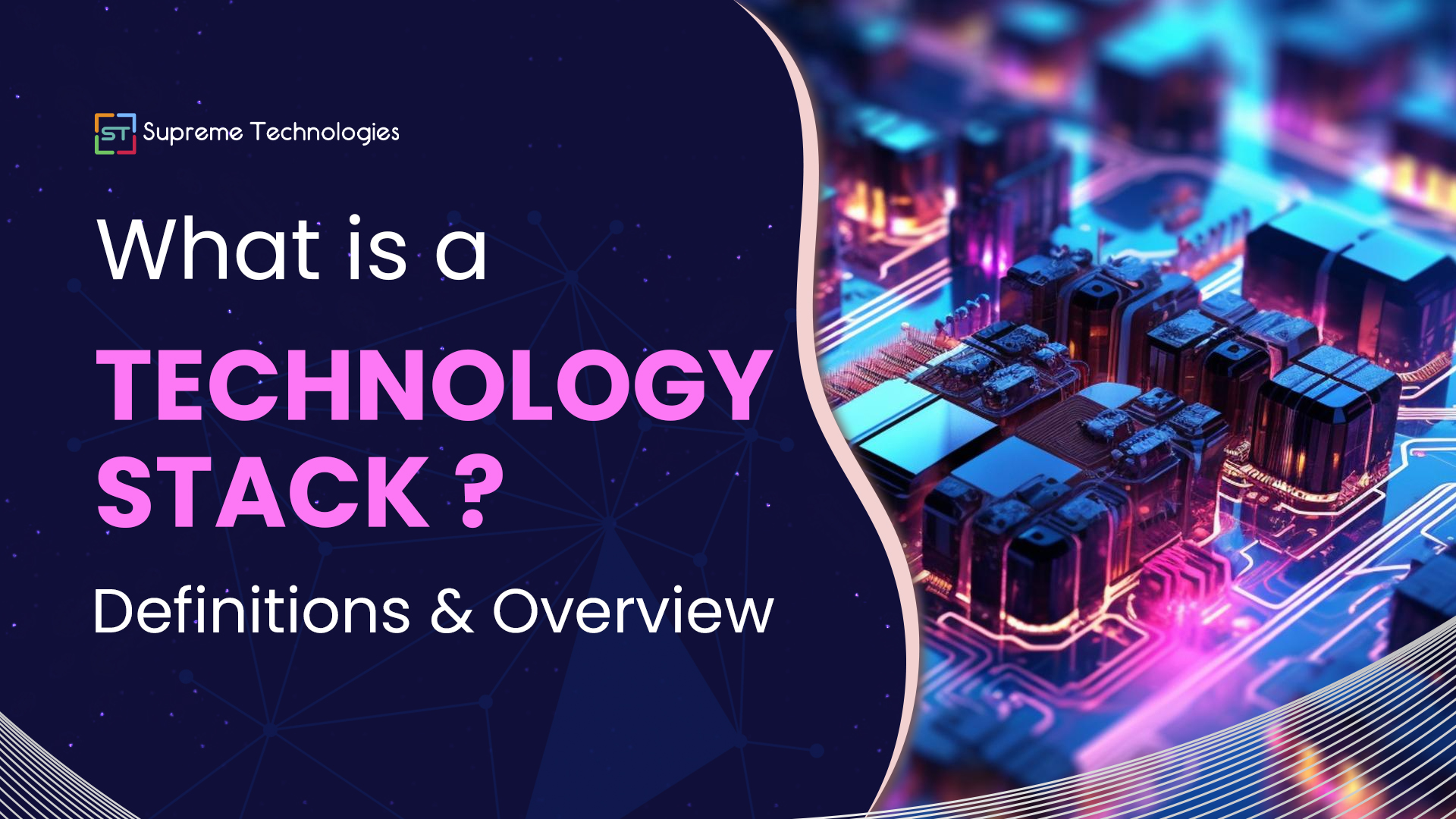A technology stack is a collection of software tools and technologies used to create applications and websites. It’s like a toolkit developers use to build, run, and manage software projects. In this blog, we will explain a technology stack. Also, learn about the various tools and technologies it includes, and understand how they work together to bring applications to life.
So, let’s get started!
What Is A Tech Stack?
A tech stack is also renowned as a software or development stack. It is a combination of programming languages, and frameworks, that work together to develop digital products or solutions like websites, mobile, and web applications.
Generally, a tech stack consists of two elements:
- The frontend (client-side)
- Backend (server-side)
These two elements work together to create a working tech stack.
There are multiple web development tech stacks, but not all are made equally. Choosing the right tech stack can be difficult, especially for startups and small businesses. They have limited budgets and resources, hence selecting the right tech stack is essential to mobilizing their software products.
Key Components of Tech Stack

Three elements make up a technology stack. These are:
Client-side
The client side of the tech is the frontend tech stack. Generally, client refers to anything that users see or engage with on screen. The main part of the frontend stack is to create the best user experience, smoother user interface, and simple internal structure. In simple terms, it is responsible for the design, format, and navigation of the website, web, or mobile apps.
The front-end technologies include:
- CSS
- HTML
- Javascript
- and UI libraries and frameworks
Server Side
The server side of the tech stack is also known as the backend technology stack. It refers to the inner workings of a site, or app that users can’t see. Think of this as electronic power stations that generate electricity in your home, offices, or any place. They seem invisible in the background but they are essential to keep the operations running efficiently and smoothly.
Database
Additionally, the database is the third element of the technology stack. It enables the storage of applications such as profiles and information about the products or items, and software.
Top 10 Stacks Used For Software Development
These are some top software stack(s) that are used for software development:
LAMP Stack
- This stands for Linux (Operating System), Apache (Web Server), MYSQL(Database), and PHP(Programming Language).
- Currently, LAMP is the open-source software tech stack used to deliver and create web applications.
- It easily handles web pages where content can change at any time when the page is loaded.
- This allows you to select components as per your specific requirements.
MEAN Stack
- MEAN Stack consists of MongoDB(Database), Express JS(Backend Framework), Angular(Frontend Framework), and Node Js(Runtime Environment).
- MEAN is a Java Script stack that enables you to use a single language throughout the stack.
- This stack’s technologies are best for cloud hosting since they are flexible, scalable, and extensible.
MERN Stack
- This is similar to MEAN but the difference is there is React.js instead of Angular.js.
- MERN Stack uses JSx – a syntax extension to Javascript which provides structure components that developers find super familiar.
- React uses DOM (Document Object Model) that enables you to make changes easily.
Ruby on Rails Stack
- Ruby under Rails or Rails is a web application framework written in Ruby under the MIT license.
- It’s open source, object-oriented, and follows the model-view-controller (MVC) pattern, giving default structures for databases, web services, and pages.
- ROR(Ruby on Rails) provides several amazing features like database cable creations, migrations, and framing of views allowing rapid application development.
- You might see Ruby on Rails in action when developing a content management system, ensuring a smooth and user-friendly content creation process.
.NET Stack
- Dot NET is an open-source platform made up of tools, programming languages, and libraries for developing scalable and high-performing database, web, and mobile applications.
- With various implementations, .NET enables your code to flex across Linux, macOS, Windows, iOS, Android, and much more.
- Three Microsoft Supported Languages for.Net are C#, F#, and Visual Basic. Several third-party languages also perform better with the Dot NET.
Python-Django Stack
- Django, a high-level Python web framework, makes web development swift with a clean design. Python and Django often join forces for full-stack applications.
- Making use of the Python-Django stack allows you to tap into modern software development technologies like PyCharm, Python, HTML, CSS, and JavaScript.
- Developers should integrate this stack with the Apache Web Server, MySQL, and the Django framework to enhance server-side development.
Flutter Stack
- Google developed this open-source framework for creating applications across several platforms from a single codebase.
- Powered by Dart, a speedy language, Flutter allows developers to create fast apps across platforms.
- This can use Google Firebase on the backend which enables you to develop highly scalable applications.
- With a built-in widget catalog and UI toolkit, this technology stack lets you construct visually stunning, high-performance mobile apps compiled natively.
React Native Stack
- React Native, a JavaScript framework for building native iOS and Android apps. It’s based on React, Facebook’s UI development library.
- This tech stack application is written with a combination of JavaScript and XML markup, rendering with genuine mobile UI components for a native look.
- Applications developed with the React Native technology stack ensure high reliability, optimize performance and deliver an exceptional user experience.
- Developers get a time-saving treat—up to 100% code reuse across different environments. Efficiency at its finest!
Java Enterprise Edition(Java EE) Stack
- This technology stack offers a platform for developers featuring enterprise capabilities such as distributed computing and web services.
- Using Java EE to build an enterprise resource planning (ERP) system, where the scalability of Java can manage complex business processes.
- Java EE has many specifications for developing web pages, reading and writing from databases, and handling distributed queues.
Serverless Stack
- This is one of the latest trending software developments that lets developers just focus on the code rather than the infrastructure and server management.
- Powered by cloud services like AWS Lambda, Google Cloud Functions, and Azure Functions, the serverless stack crafts scalable, budget-friendly apps without dedicated servers.
- Since the serverless tech stack architecture is based on the Function as a Service Model (FaaS), you don’t need to spend money on unusual server resources.
- This stack easily handles traffic spikes and resource scaling during peak times—the cloud provider takes care of it automatically based on request volume.
Advantages of Using Tech Stacks in Software Development
Keep reading to know the essential benefits of the technology stack:
- It boosts developers’ efficiency and productivity by streamlining the development process.
- The tech stack enables developers to focus on developing the codes and building amazing features rather than dealing with issues.
- The technology stack offers a standardized approach to development, making sure of consistency throughout the project. Plus, it provides crucial guidelines and best practices for coding, architecture, etc.
- This improves software quality through code reuse and maintainability.
- Modern software development technologies can easily adapt applications to changing business demands by increasing traffic, data volume, and user interactions without requiring significant architectural changes.
- By choosing the right stack, developers can also reduce the chances of encountering technical problems, security vulnerabilities, or lack of support.
- The presence of free and open-source frameworks in the technology stack lowers your licensing costs and enables you to build amazing features without spending too much.
Conclusion
Choosing the right tech stack is key to building good software. We have examined different stacks like LAMP, MEAN, and others, each offering a unique advantage. You should choose the best stack based on what you’re building, your team expertise, and your goals. There’s no one perfect stack for everything. Think about things like how well it can grow, how fast it works, and how easy it is to use when you choose. By picking the right technology stack, you can set up your project for success and make powerful, smooth-running apps.
Ready to boost your tech game? Reach out at Supreme Technologies now!




